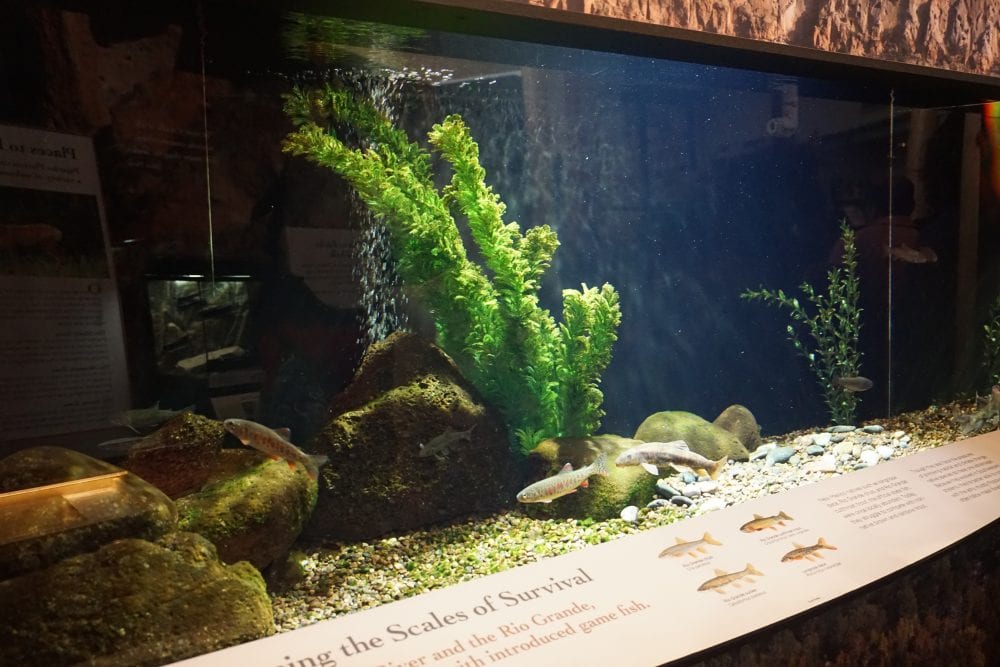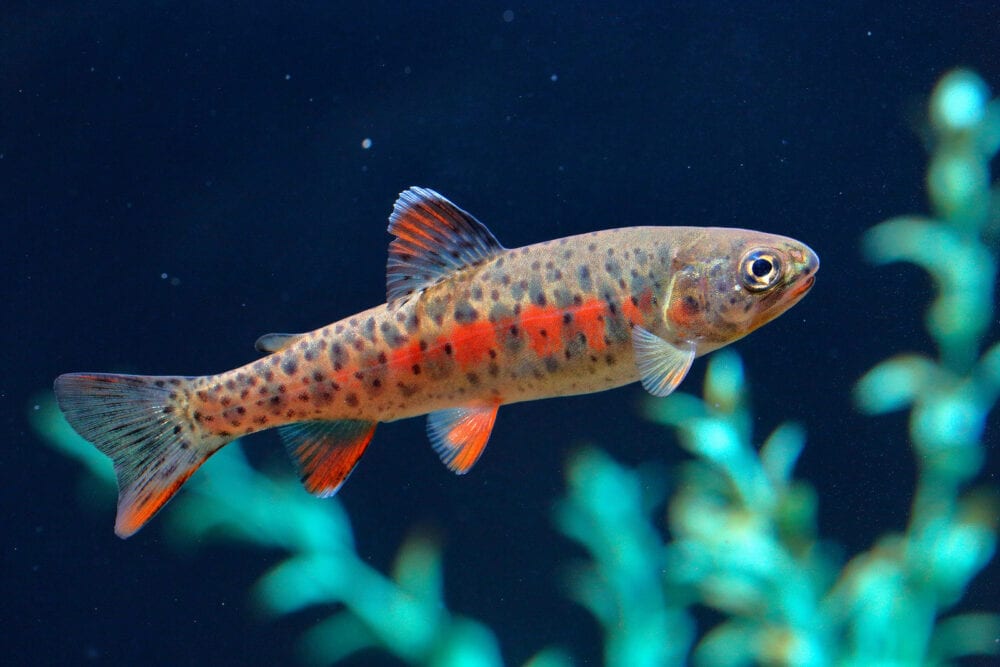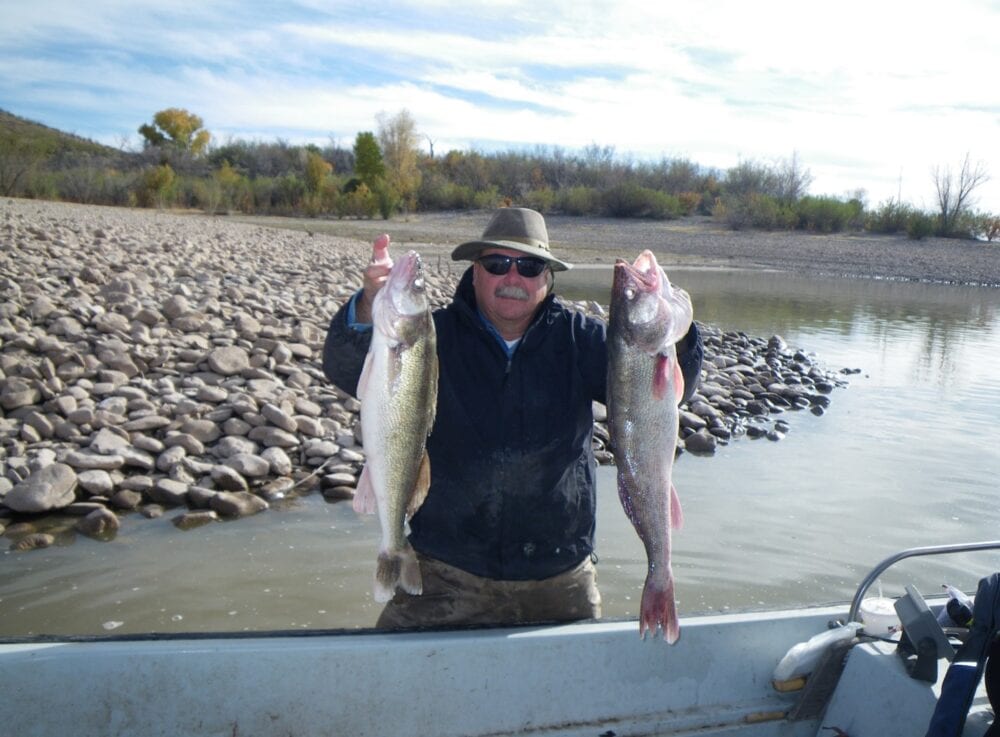
By Casey Harthorn, New Mexico Department of Game & Fish
In New Mexico, we have both native and introduced fish species. Today, we will see what some of the differences are between the two, we will investigate why we introduce different species, look at some examples of native and introduced species, and discuss some of the ecological consequences of introducing fish.
When talking about native species, we are referring to species that evolved through time to live in a specific environment. For instance, our state’s Gila trout evolved within the Gila watershed system. When we refer to an introduced species, we are referring to a species that evolved in one watershed and was introduced (normally) by humans, into another watershed. The rainbow trout, for example, evolved in the ocean and was introduced into the waters of New Mexico.
So why would anybody introduce a species of fish into an environment where it did not naturally evolve? Well, good question. New Mexico is an arid state — we just do not have a lot of water. While we do have a few rivers and streams, there are very few natural lakes. These rivers and streams are populated with native fish species, primarily suckers, dace, and chubs. As New Mexico entered the industrial age, the need to irrigate increased, as did the need to manage our limited water resources, so along came dams. Dams were constructed along New Mexico’s rivers to create reservoirs, thus changing the aquatic environment from rivers to lakes. There is a good chance that what you know as a lake here in New Mexico is really a reservoir, a manmade lake.
To fish, a river or stream is a completely different environment than that of a lake or reservoir. We cannot simply take a fish from a stream environment and expect it to thrive in a lake environment and vice versa. Imagine that you lived your entire life in the middle of New York City, and then you were relocated to the isolated tundra of Alaska. How long do you think you would survive? Fish are the same: some evolved to live in stream environments, while others do better in lake environments. When the aquatic environment changed, fish were stocked to match this new environment. Some fish are stocked to increase angling opportunities, some are stocked for management purposes, and some are stocked illegally.
Just looking at the sportfish species within New Mexico waters, which sportfish species are native, and which are introduced? Let us look at the specific fish families within the sportfish community and identify native or introduced members.

Salmonidae – Trout Family
| Gila Trout | Native |
| Rio Grande Cutthroat Trout | Native |
| Brook Trout | Introduced |
| Rainbow Trout | Introduced |
| Brown Trout | Introduced |
| Lake Trout | Introduced |
Centrarchidae – Sunfish Family
| Bluegill | Native |
| Green Sunfish | Native |
| Longear Sunfish | Native |
| Largemouth Bass | Native and Introduced |
| Crappie | Introduced |
| Smallmouth Bass | Introduced |
| Spotted Bass | Introduced |
Percidae – Perch Family
| Lake Perch | Introduced |
| Walleye | Introduced |
Esocide – Pike Family
| Northern Pike | Introduced |
| Tiger Muskie | Introduced |
Cyprinidae – Minnow Family
| Common Carp | Introduced |
Moronidae – Temperate Basses
| Striped Bass | Introduced |
| White Bass | Introduced |
Ictaluridae – Catfish Family
| Black Bullhead | Native |
| Channel Catfish | Native |
| Flathead Catfish | Native |
| Blue Catfish | Native |
As you can see, there are a lot of introduced species of fish swimming within New Mexico’s watersheds. However, there are also very many native species still swimming in New Mexico. While we normally hear about the sportfish species, it is important to note that the native species are also extensively managed and monitored by the New Mexico Department of Game and Fish. Great care is taken to ensure that all introduced species do not interfere with the native fish community.

To enhance angling opportunities, the Department of Game and Fish stocked rainbow and brown trout throughout the state for years. It was later discovered that this stocking was having a negative effect on the native trout populations. Rainbow trout were breeding with the Rio Grande cutthroat trout, affecting the genetic pool, and brown trout were much more aggressive and out-competing the native species for resources.
Once the Department realized the impact these stockings were having on the native population, it acted. Populations of pure native trout were identified and isolated, and all stocking of introduced species was stopped in these areas. Historical ranges of native trout were identified, isolated with fish barriers, cleaned out of nonnative species, and restocked with genetically pure native trout. Rio Grande cutthroat and Gila trout are reared in local hatcheries and released into their native ranges, thus increasing their populations. These are just two examples of ongoing work that the Department is taking to protect native species.
You might be wondering, if native trout are being reared in hatcheries, why doesn’t the Department of Game and Fish simply stop producing and stocking rainbow trout and stock the native trout instead? Well, for a few reasons. Rainbow trout have been cultured for so many years that they have evolved into an amazingly easy species to raise, transport, release, and catch by anglers. The rainbow trout is probably as domesticated as a fish can be, whereas the native species are wild and extremely hard to rear in a hatchery environment. Kind of like the difference between a dog and a wolf! The rainbow trout is an ideal species for our urban and small lake fisheries programs. They are easy to raise and stock, and anglers enjoy catching and eating them. The native trout, on the other hand, are wild, provide a much greater challenge to anglers, and survive much better in the wild.
Despite our efforts to keep native and introduced species separated, rainbow trout sometimes escape or are illegally introduced into native trout waters. So, to mitigate the effects these trout may have on the native population, the Department now only raises and releases sterile fish. All the rainbow trout in the state’s hatcheries are triploid rainbow trout. A triploid trout is a sterile trout formed from a manipulated egg. The eggs are not genetically altered, but temperature-shocked to form triploid instead of diploid individuals, which means they have three sets of chromosomes instead of the normal two, and are infertile.
Will the State ever be free of introduced fish species? Probably not. Many of these introductions are important to the anglers of New Mexico as well as to the local communities. The native species are managed and maintained within their natural environment, while the introduced species are managed within the manmade environment.
Here are some of the things we encourage you to think about when considering our state’s fish species. If you have thoughts you’d like to share, please leave a comment below!
Can an introduced species ever be considered a native species? As an example, largemouth bass have been stocked into some of New Mexico’s waters for over 100 years. Are they still considered an introduced species?
Should the watersheds of New Mexico be returned to their natural state?
The Gila River is the state’s last remaining free flowing river. Should it be dammed up?
